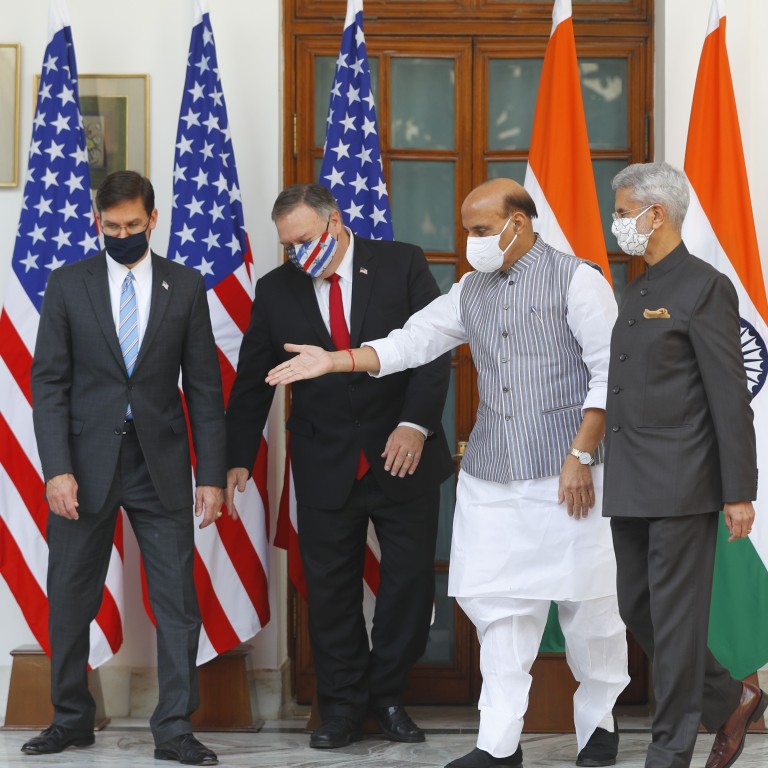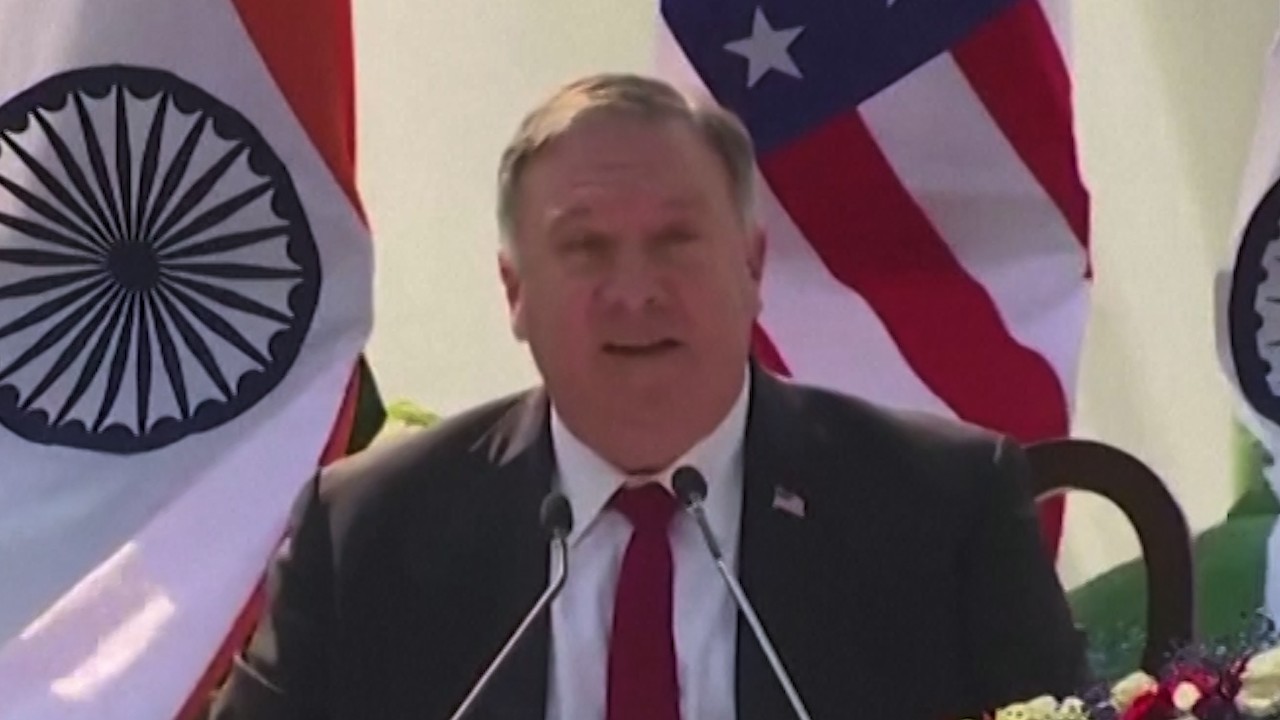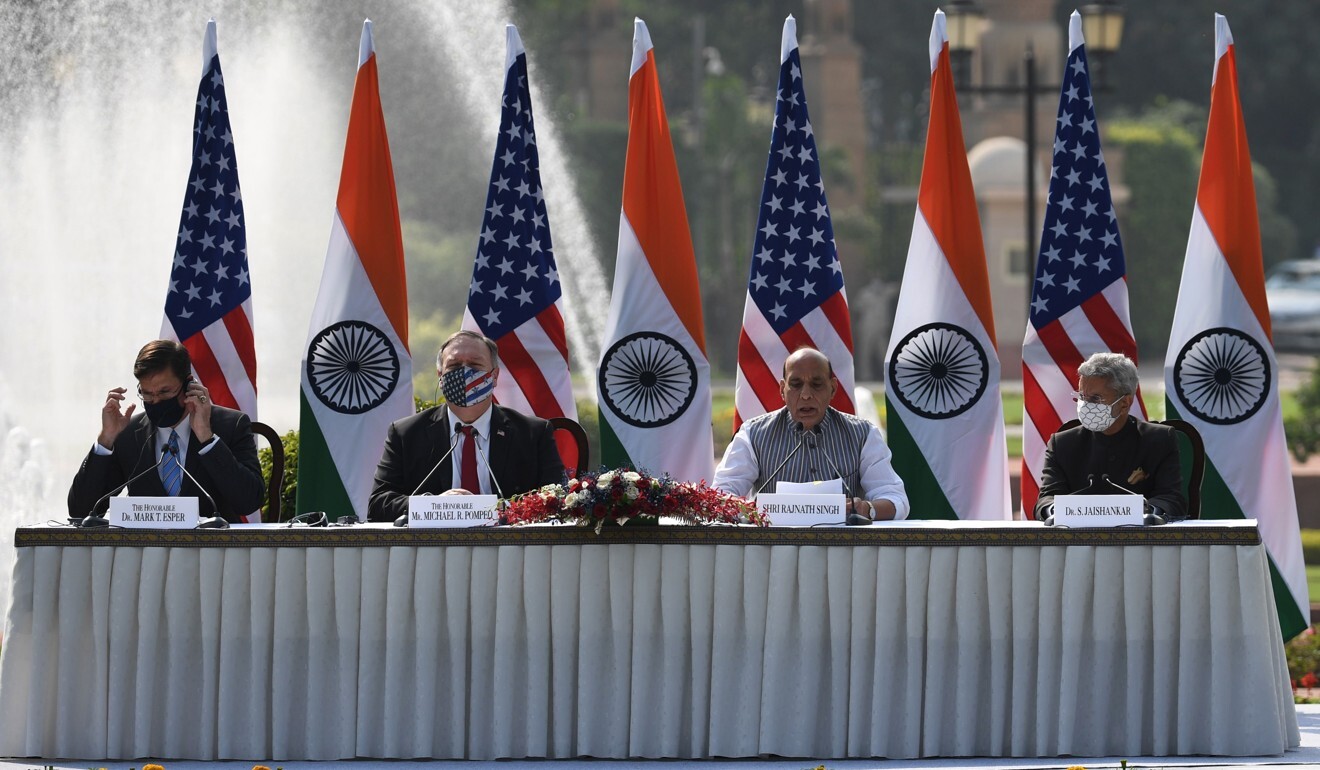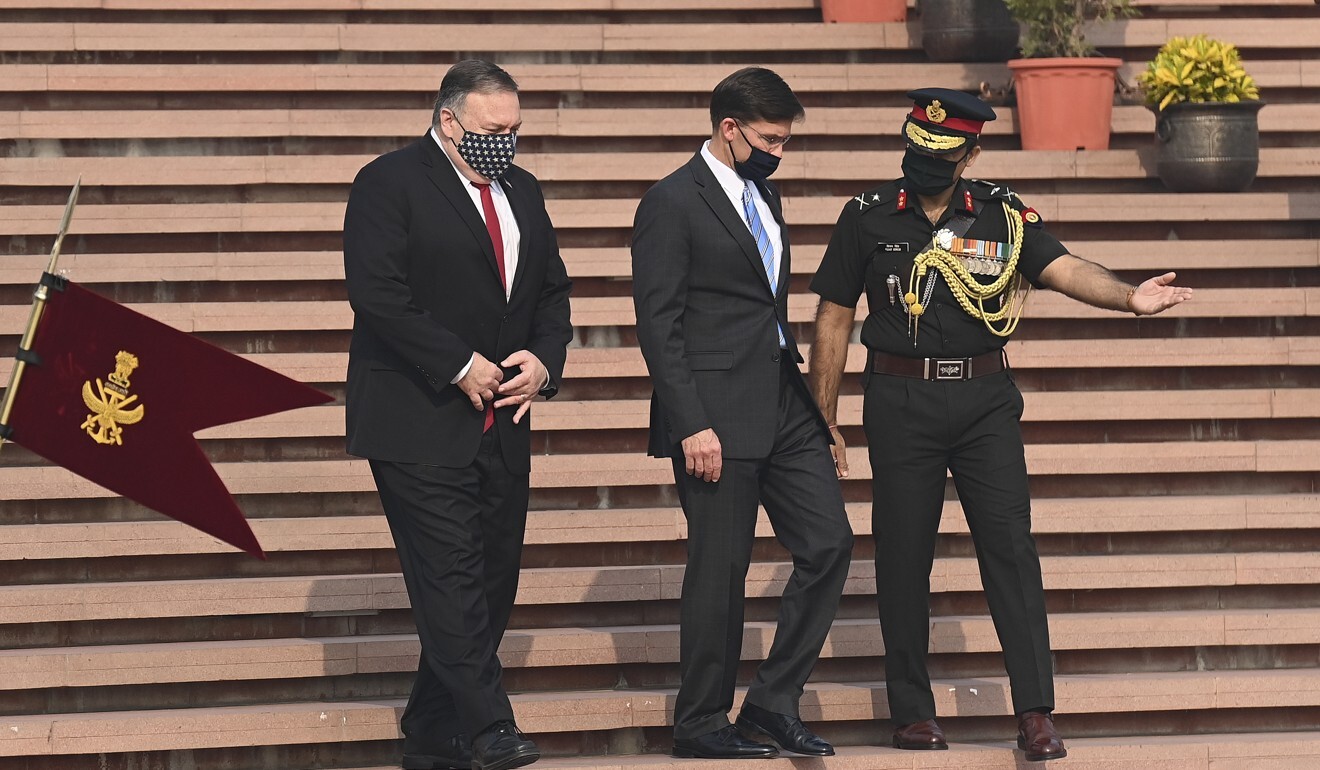
China looms over high-level talks as US, India sign defence pact
- The agreement will allow Washington and New Delhi to share satellite data for use in attacks and better surveillance against adversaries
- US state secretary Pompeo and defence secretary Esper took a harder line on China than India’s external affairs minister Jaishankar and defence minister Singh

00:39
Pompeo warns of China threat as US and India sign defence pact
On a visit to New Delhi earlier this month, US Deputy Secretary of State Stephen Biegun had called China the “elephant in the room” in the US-India relationship. On Tuesday, as details emerged of the meetings, both countries seemed to have taken note.
As India eyes US military deal, neutrality on China takes back seat
The US secretary of state said at a later press conference that there had been “robust discussions on the Chinese Communist Party”, adding that it was “no friend to democracy”. Backing New Delhi in its current stand-off with Beijing, Pompeo said the US would “stand with India as they confront threats to their sovereignty and liberty”.

Added Esper: “We stand shoulder to shoulder in support of a free and open Indo-Pacific for all, particularly in view of increasing aggression and destabilising activities by China.”
According to the transcripts of the meeting posted by the US State Department, Singh in his opening remarks raised the issue of the India-China border standoff, saying India was “challenged by reckless aggression on its northern borders”.
India-China border dispute explainer: is peace really on the horizon?
External affairs minister Jaishankar said the Indo-Pacific region was “a particular focus” during the talks, a thinly veiled reference to Beijing having featured in discussions. He added that India’s vision of a “peaceful, stable and secure” region was possible only by “ensuring freedom of navigation in international seas, promoting open connectivity and respecting the territorial integrity and sovereignty of all nations”.
“At a time when it is particularly important to uphold a rules-based international order, the ability of India and the US to work closely in defence and foreign policy has a larger resonance,” Jaishankar said.
‘IMMENSE BOOST’
During the talks, US defence secretary Esper said the two sides should “institutionalise and regularise” military cooperation in the Indo-Pacific, a reference to persistent demands from Washington to formalise the Quad.
At a news briefing in Beijing, Chinese foreign ministry spokesman Wang Wenbin urged Pompeo “to abandon his Cold War mentality, zero-sum mindset, and stop harping on the ‘China threat’”.

02:04
New video shows clash between Indian and Chinese troops on border
The talks saw India and the US sign the Basic Exchange and Cooperation Agreement (BECA), a military pact that will allow them to share geospatial intelligence for use in attacks and better surveillance against adversaries. It will also allow the US to include the latest navigational technology in the fighter jets it supplies to India, and comes amid Esper’s efforts to get India to purchase more US F-18 jets instead of Russian weaponry.
Analysts said the BECA signalled a new level of partnership between the US and India, which has made clear it is non-aligned and has been wary of other powers displacing its influence across South Asia.
As India-China border stand-off endures, a fear: Ladakh is the new Kashmir
The pact is the concluding part of a set of four so-called foundational military agreements through which New Delhi and Washington have pledged mutual defence support to each other, including the use of military bases. The first, the General Security of Military Information Agreement (GSMIA), was signed in 2002, while the Logistics Exchange Memorandum of Agreement and the Communications Compatibility and Security Agreement followed in 2016 and 2018, respectively.
Indian military sources said the BECA could pave the way for New Delhi to step up arms purchases from Washington that depended on American geospatial data and satellite imagery, such as surveillance drones and even armed drones.
An Indian government statement after Singh’s meeting with Esper said the two sides had discussed “potential new areas of cooperation”, while Esper welcomed India’s move to extend an invitation to Australia for the upcoming Malabar naval exercises that will also involve the other Quad countries, namely the US and Japan.

The agreement is also expected to improve India’s capabilities while it is locked in its most serious military stand-off with China to date, with thousands of troops from both countries facing off along the countries’ disputed border since May. There is no sign the situation is any closer to being resolved, though there have been no violent flare-ups in the past two months.
According to Sameer Patil, fellow for international security studies at the Mumbai-based think tank Gateway House, the BECA could provide an immense boost to India’s surveillance capabilities.
“BECA would give India access to real-time satellite imagery which is very important for it, especially now amid the stand-off,” he said. “India can monitor, in real-time, the movement of Chinese troops, their deployment and activities, and American analysts can help India break this data down.”
CLOSER SECURITY TIES
These developments are likely to impact India’s response to China amid the current tensions, especially now that a typically harsh winter has set into the Himalayan region, according to a retired major general in the Indian Army who spoke on condition of anonymity, citing the sensitivity of the issue.
“The winter makes it very tough for on-ground surveillance by our troops through patrolling. The visibility will be so low that it will be virtually impossible for troops to keep a check on Chinese activities,” he said. “Through such times, precise satellite imagery and surveillance [provided through the] BECA will enable us to not just keep a check on but also respond quicker to any assertiveness.”
However, Patil from Gateway House said, the pact might not help India immediately. “Such agreements generally take some time to operationalise, from a few months to more than a year, but the two sides are likely to expedite this.”
Such assistance will also fall into a larger pattern of Washington’s backing and support for New Delhi throughout the border stand-off.
As US hones Indo-Pacific strategy, South Asian nations come into focus
Indian media reports have said that the US had responded positively to Indian demands for logistical assistance to enable it to position its soldiers in the Ladakh region through the winter, during which temperatures routinely fall below minus 40 degrees Celsius. Indian defence journalist Ajai Shukla in a webinar earlier this month said the US had “offered support to the Indian side” at least four times during the stand-off, apart from regular sharing of intelligence.
The US has come out in support of India’s stance politically, with Pompeo earlier in the month saying that India “absolutely need(s) the US as their ally and partner in this fight” because the Chinese have “amassed huge forces” against it. The US has also “strongly opposed” Chinese claims over the Indian state of Arunachal Pradesh, slamming Beijing’s “unilateral attempts to advance territorial claims by incursions”.
Pompeo and Esper are spending two days in New Delhi as part of their five-day Asian tour, on which they will also be visiting Sri Lanka, the Maldives and Indonesia. Tuesday’s talks were the third time the two countries have held such high-level discussions – the first 2-plus-2 dialogue was held in New Delhi in September 2018, while another session was held in Washington last December.

Some analysts feel Tuesday’s pact also indicates that India’s stance towards non-alignment and strategic autonomy might be changing. India-US ties have been growing closer since the early 2000s, when the two countries signed the GSMIA military agreement that enabled intelligence-sharing between them. Since then, New Delhi and Washington have gone on to sign a landmark deal that enabled the sale of American nuclear technology for civilian use in India in 2008.
This growing closeness has translated to greater cooperation, especially in the defence sector. When President Trump visited India in February, the two countries reached a deal for the US to supply 24 MH-60R Seahawk helicopters and six Apache attack helicopters worth US$3 million. On Tuesday, defence secretary Esper hinted that arms exports were likely to grow, with the sale of more fighter jets and unmanned aerial systems to India in the pipeline.
However, this might still not be enough for the US to unseat Russia from being India’s biggest arms supplier, going by data from the Stockholm International Peace Research Institute – and, according to Gateway House’s Patil, New Delhi is unlikely to give up its autonomy any time soon.
“India can still defend itself as a strategically autonomous nation because it does not have any treaties with the US to make them allies,” he said. “There is no written commitment from the US that it will defend India against any attack by China or Pakistan.”
Additional reporting by Associated Press


